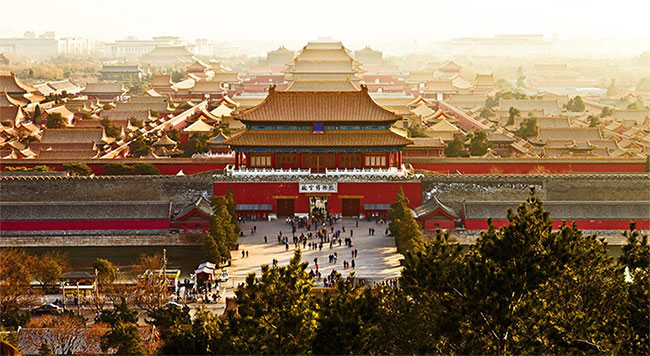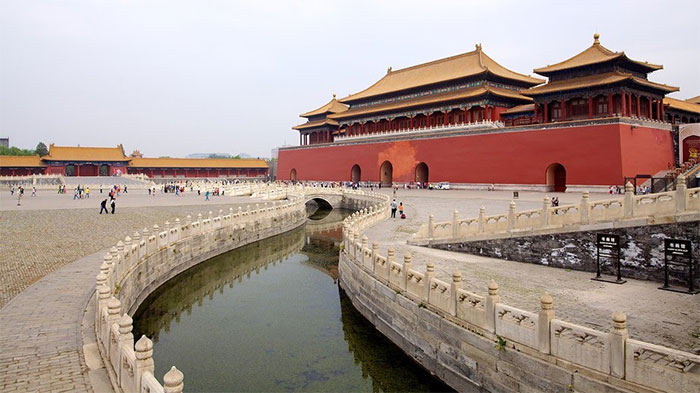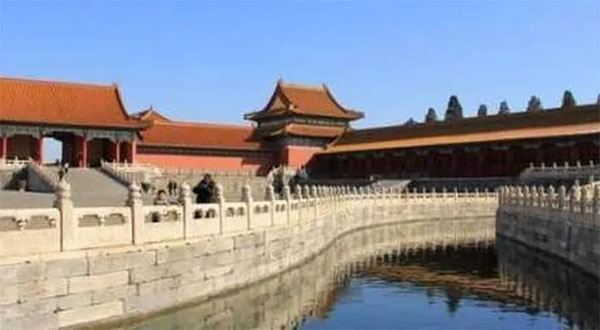The strange and fantastical story of the world’s largest python, said to be 612 years old, lurking beneath the heavily guarded Forbidden City has just been revealed, leaving the world in shock.
In such a vast world, there are certainly many wonders that not everyone has had the chance to behold. For instance, a gigantic python that is 612 years old? Could this be a fictional oddity conceived by imagination? Not at all; for the people of China, there truly exists a giant python that currently resides in the grand and closely guarded Forbidden City (the Imperial Palace in Beijing). Moreover, this python is not just an ordinary snake; it can be said to be “the largest python in the world today.” This is indeed the comparison to the Golden Water River running through the Forbidden City.

Aerial view of the Forbidden City.
Pythons (or large snakes) are creatures of nature and also serve as symbols in human society. So why is the Golden Water River referred to as the “giant python” with its long history of 612 years, hidden within the Forbidden City? According to historical records, during the Ming Dynasty, one night, the sky suddenly erupted with thunder, torrential rain, and fierce winds, creating a noise that shook the world. Tall trees swayed violently in the wind, petals flew everywhere, and animals cried out, searching for shelter. The sky was covered in dark clouds, and even the door to the emperor’s resting chamber was brutally smashed open.
A flash of lightning cut through the pitch-black night, illuminating the face of the emperor as he lay at rest. His face, while sleeping, seemed somewhat restless, displaying tension as his body trembled. With each flash of lightning, the emperor’s visage appeared and disappeared, beads of sweat dotting his face and falling onto the dragon-embroidered blanket. The next day, the emperor recounted the events of his dream from the previous night, particularly about the enormous python he encountered in his slumber. After related scholars analyzed this, they decided to construct a “python” in the city.

The emperor shared his dream, and they subsequently decided to build a “python” in the city. (Illustrative image).
The word “xà” in Chinese means snake, regarded as a good omen for abundant harvests and symbolizing prosperous generations. “Mãng xà” (python) carries significant connotations not only in China but also holds extraordinary meanings across most nations. In later analyses, why do people often liken an ordinary river to a “python” winding and twisting?
We all know that aesthetic architecture is also applied within this vast palace. And symmetry is one of the very trendy and popular architectural features of palace designs. Numerous places within the palace highlight the beauty of symmetry. Meanwhile, the presence of this winding river is unique and does not conform to symmetry. Despite not being constructed based on symmetrical architecture, it occupies the entire palace and still provides a pleasing view. This clearly demonstrates the intent to design the river in the shape of a python.
In fact, this is quite understandable. As mentioned earlier, the python (a large snake) symbolizes abundance and fruitful harvests. As the ruler of the realm, holding all power, any emperor would wish for their nation to thrive and never decline. Therefore, this “python” in the Forbidden City embodies the most profound significance.
It is known that in ancient Chinese traditional culture, gold, wood, water, fire, and earth were often used to represent different directions. Among them, gold symbolizes the West, wood symbolizes the East, water symbolizes the North, fire symbolizes the South, and earth symbolizes the center. In reality, the waters of the Golden Water River originate from the Yuyuan Mountain in the western suburbs of Beijing and are channeled in from the moat at the northwest corner of the Forbidden City.

This python has been hiding in the Forbidden City for too long. (Illustrative image).
The terrain of the Forbidden City is high in the north and low in the west and east, resulting in the Golden Water River flowing from the northwest to the southeast. Its specific route is: entering the palace from the northwest corner of the Forbidden City, it flows southward along the western wall towards the vicinity of the West Flower Gate, then heads east through the Wuying Gate, the Taihemen Square, the Wenhua Palace… and other areas, finally flowing out from the Donghua Gate at the southeast corner of the Forbidden City, merging into a larger river.
The section of the Golden Water River within the Forbidden City is approximately 2,100 meters long, with an average depth of about 4 meters. The river features sections that are both clear and murky, straight and winding, wide and narrow, with the widest point measuring 11.8 meters and the narrowest not exceeding 2 meters. The riverbed and banks are paved with stone. This winding river resembles a giant python, and its emerald green waters provide vitality to the Forbidden City, while its shape enhances the architectural artistry of the palace. However, the more significant meaning of the Golden Water River for the Forbidden City lies in its scientific applications, playing a crucial role in fire prevention, drainage, and climate regulation of the ancient buildings within the Forbidden City.
However, 612 years have passed since the Yongle Dynasty (1406) when this river was constructed. This means that this python has been hiding in the Forbidden City for far too long. It is an indispensable part of the Forbidden City, reflecting not only scientific significance but also the integration of architecture, culture, and ancient Chinese artistry.
- The thousand-year-old structure rivaling the Forbidden City: Built without nails, wood free of termites
- Revealing the examination paper of a top scholar that shocked the world with handwriting resembling modern printed text
- Uncovering the tomb of an emperor that was stolen, unexpectedly discovering what he still clutched in his hand




















































